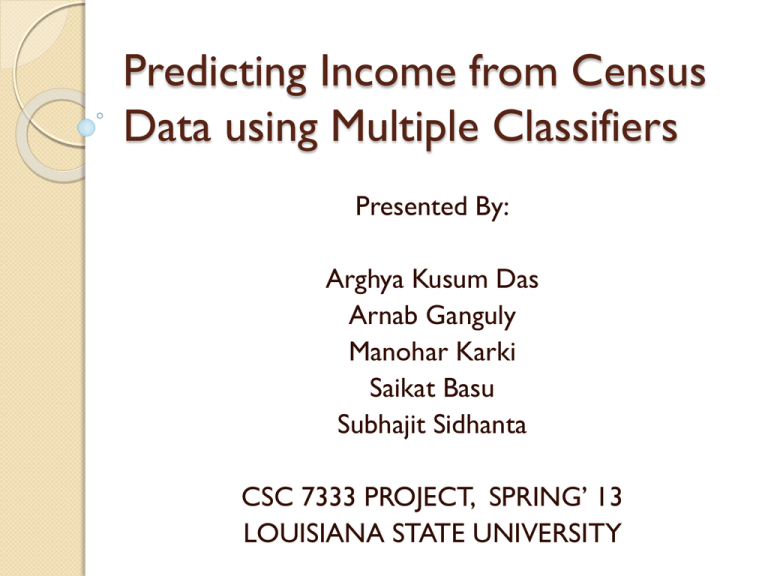
Predicting Income from Census
Data using Multiple Classifiers
Presented By:
Arghya Kusum Das
Arnab Ganguly
Manohar Karki
Saikat Basu
Subhajit Sidhanta
CSC 7333 PROJECT, SPRING’ 13
LOUISIANA STATE UNIVERSITY
Agenda
Objective
Data
Methods
Artificial Neural Network
Normal Bayes Classifier
Decision Trees
Boosted Trees
Random Forest
Results
Comparisons
Observations
CSC 7333 - Dr. Jianhua Chen
2
Objective
Analysis of Census Data to determine
certain trends
Prediction task is to determine whether a
person makes over 50K a year.
Analyze the accuracy and run time of
different machine learning algorithms
CSC 7333 - Dr. Jianhua Chen
3
Data
•
48842 instances (train = 32561, test = 16281)
•
45222 if instances with unknown values are removed
(train = 30162, test = 15060)
•
Duplicate or conflicting instances : 6
•
2 classes : >50K, <=50K
•
Probability for the label '>50K' : 23.93% / 24.78%
(without unknowns)
•
14 attributes : both continuous and discreet-valued.
The Attributes
•
•
•
•
•
•
•
•
•
•
•
•
•
•
Age
Workclass
fnlwgt
Education
Education-num
Marital-status
Occupation
Relationship
Race
Sex
Capital-gain
Capital-loss
Hours-per-week
Native-country
Data SnapShot
Artificial Neural Network
•
Sigmoid function is used as the squashing function.
•
No. of Layers = 3
•
256 nodes in first layer. Second and third layers
have 10 nodes each.
•
Terminate if no. of epochs exceed 1000 or rate of
change of network weights falls below 10-6.
•
Learning rate = 0.1
Normal Bayes Classifier
•
The classifier assumes that:
• Features are fairly independent in nature
• the attributes are normally distributed.
•
It is not necessary for the attributes to be
independent; but does yield better results if they are.
•
Data distribution function is assumed to be a Gaussian
mixture – one component per class.
•
Training data Min vectors and co-variance matrices
for every class Predict
Decision Trees
Regression tree partition continuous values
Maximum depth of tree = 25
Minimum sample count = 5
Maximum no. of categories = 15
No. of cross validation folds = 15
CART(Classification and Regression Tree) is used as the tree
algorithm Rules for splitting data at a node based on the
value of variable Stopping rules for deciding on terminal
nodes Prediction of target variable for terminal nodes
CSC 7333 - Dr. Jianhua Chen
9
Boosted Trees
•
Real AdaBoost algorithm has been used.
•
Misclassified events Reweight them Build &
optimize new tree with reweighted events Score
each tree Use tree-scores as weights and average
over all trees
•
Weak classifier classifiers with error rate slightly
better than random guessing.
•
No. of weak classifiers used = 10
Trim rate Threshold to eliminate samples with
boosting weight < 1 – trim rate.
Trim rate used = 0.95
Random Forest
•
•
•
•
•
Another Ensemble Learning Method
Collection of tree predictors : forest
At first, it grows many decision trees.
To classify a new object from an input vector,:
1. It is classified by each of the trees in the forest
2. Mode of the classes is chosen.
All the trees are trained with the same parameters
but on different training sets
Random Forest (contd.)
•
No. of variables randomly selected at node and used
to find best split(s) = 4
•
Maximum no. of trees in the forest = 100
•
Forest accuracy = 0.01
•
Terminate if no. of iterations exceed 50 or error
percentage exceeds 0.1
Results
Unknown data included
Method
Correct
Classification
Class 0
false
positives
Wrong
Classification
Class 1
false
positives
Time
Accuracy
Neural Network
13734
2547
1339
1208
719
0.84356
Normal Bayes
13335
2946
1968
978
3
0.819053
Decision Tree
13088
3193
1022
2171
5
0.803882
Boosted Tree
13487
2794
1628
1166
285
0.828389
Random Forest
13694
2587
864
1723
51
0.841103
Unknown data excluded
Method
Correct
Classification
Class 0
false
positives
Wrong
Classification
Class 1
false
positives
Time
Accuracy
Neural Network
12711
2349
1804
545
545
0.844024
Normal Bayes
12226
2834
1945
889
3
0.811819
Decision Tree
12017
3043
983
2060
4
0.797942
Boosted Tree
12260
2800
1510
1290
221
0.814077
Random Forest
12621
2439
850
1589
48
0.838048
CSC 7333 - Dr. Jianhua Chen
13
Comparisons (unknown data included)
Accuracy
Time
0.85
800
0.84
700
0.83
600
500
0.82
400
0.81
300
0.8
200
0.79
100
0.78
0
Neural
Network
Normal
Bayes
Decision
Tree
Boosted
Tree
Random
Forest
Neural
Network
Class 0 false positives
2500
2000
2000
1500
1500
1000
1000
500
500
0
0
Normal
Bayes
Decision
Tree
Boosted
Tree
Decision
Tree
Boosted
Tree
Random
Forest
Class 1 false positives
2500
Neural
Network
Normal
Bayes
Random
Forest
Neural
Network
Normal
Bayes
Decision
Tree
Boosted
Tree
Random
Forest
Observations
Removing non relevant attributes improves
accuracy (Curse of Dimensionality)
Some attributes seemed to have little relevance to salary.
For example: Race, Sex.
Removing the attributes improves accuracy from by 0.21%
in decision trees.
For Random Forest, accuracy improves by 0.33%
For Boosted Trees, accuracy falls slightly by 0.12%
For ANN, accuracy improves by 1.12%
Bayes Classifier – Removing co-related
attributes improves accuracy.
Education-num highly related to Education. Removing
education-num improves accuracy by 0.83%
CSC 7333 - Dr. Jianhua Chen
15
Thank you!!!
CSC 7333 - Dr. Jianhua Chen
16










